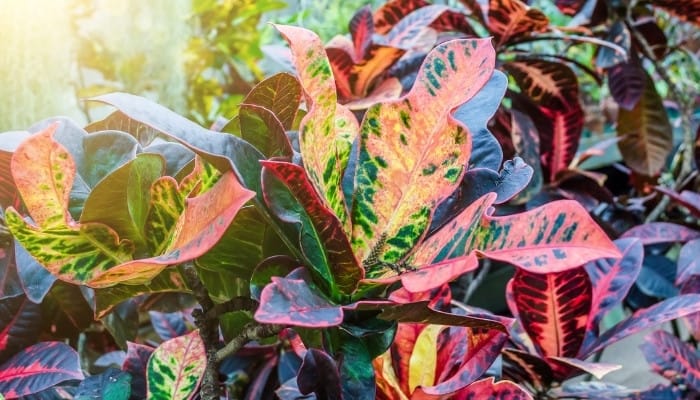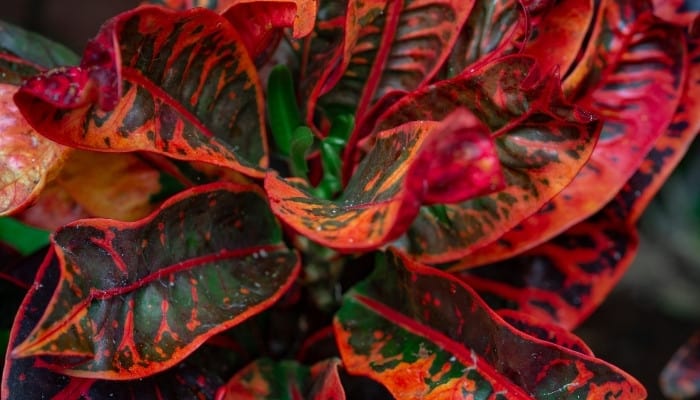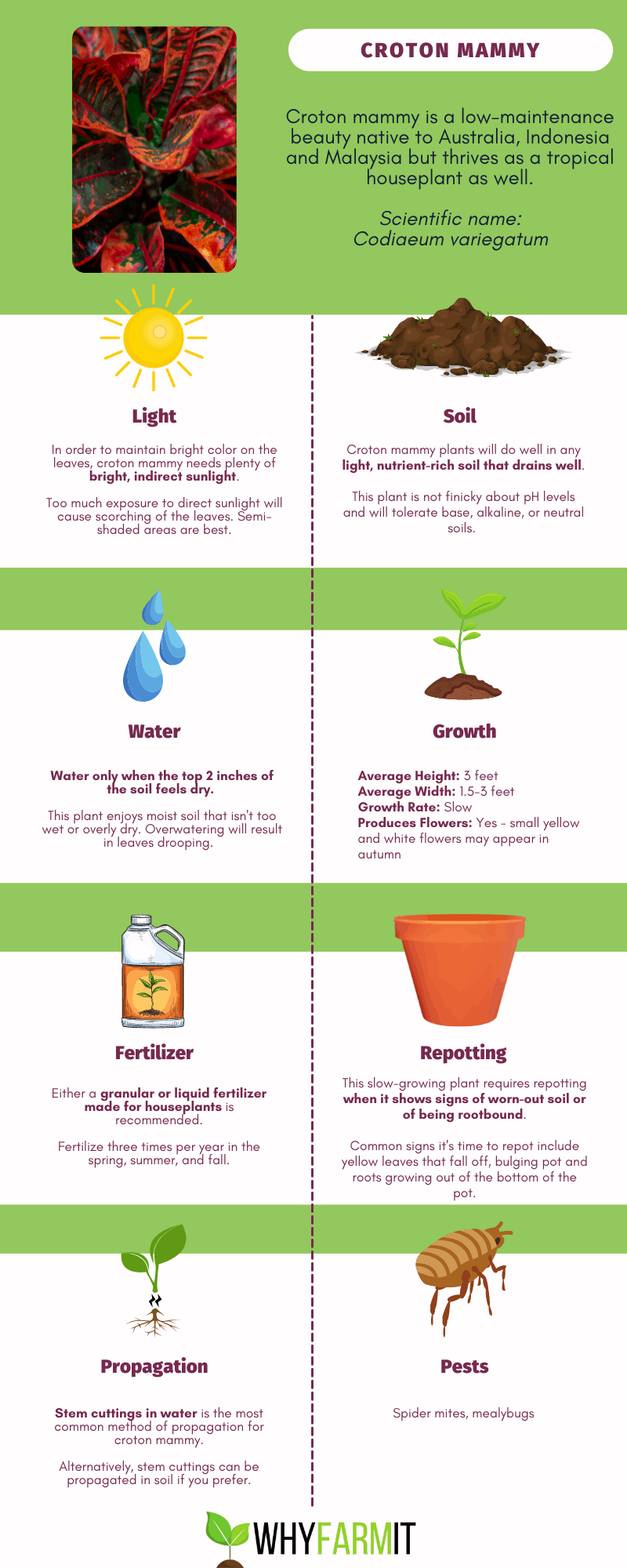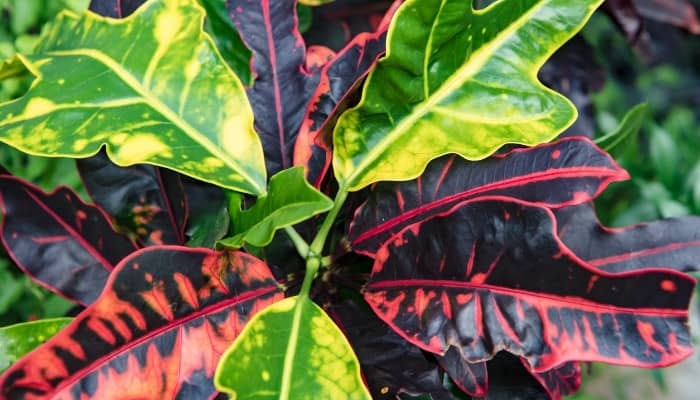Also referred to as the croton mammy or mammy croton, the Codiaeum variegatum is a vibrantly colored evergreen shrub that thrives in tropical climates.
This vibrant plant is native to Australia, Indonesia and Malaysia, where it grows in forests and scrubs.
Its popularity has evolved over time, and plant lovers worldwide have started cultivating this plant as an indoor showpiece or a decorative garden shrub.
This slow-growing plant is easy to grow and maintain and perfect for novice gardeners.
Although the croton mammy is a low-maintenance beauty, plant lovers will need to ensure they follow a few basic guidelines when adding this plant to their collection.
That’s why we have compiled this in-depth guide on growing and caring for the croton mammy.
How do you care for croton mammy? To thrive, croton mammy needs good-draining, moist soil; temperatures between 60-80℉; up to 80% humidity; and bright, indirect light to develop leaf colors. A high-quality fertilizer should be applied three times per year in the spring, summer, and fall. Over or underwatering should be avoided.
Caring for Croton Mammy: Basic Guidelines
The above table summarizes the different points we will cover to ensure your croton mammy gets the right balance of nurture and nature in its brilliantly colored life.
Do you want to learn all there is to know about keeping your croton mammy (Codiaeum variegatum) in tip-top shape?
Here’s how to get your croton mammy growing and thriving.
Complete Care Guide for Croton Mammy
Below is a comprehensive guide to understanding your croton mammy and its likes and dislikes.
This guide will arm you with the knowledge of how to keep this rainbow-colored plant happy, vivid, and thriving.
Most importantly, you’ll learn to make your croton mammy the envy of the whole neighborhood.
Croton Mammy at a Glance
The croton mammy is an undeniable showstopper with its thick glossy leaves which curl as they grow.
It’s best to keep the croton mammy in a warm environment because the more light the plant receives the more intense the leaf colors become.
These plants are great for newbie gardeners because they are so easy to grow.
- Scientific Name: Codiaeum variegatum
- Plant Type: Tropical
- Average Height: Outdoors – 10 feet (304 cm), Indoors – 3 feet (91 cm)
- Average Width: 1.5-3 feet (46-91 cm)
- Growth Rate: Slow
- Produces Flowers: Yes
- Common Pests: Red spider mites, mealybugs, thrips, scales
- Level of Care: Low maintenance
What To Do When You First Get Your Croton Mammy
If you purchased your plant from a nursery, your croton mammy might be in a pot that is already too small for it.
Purchase a larger plant pot with enough drainage holes to ensure water does not collect in the bottom.
Plant your croton mammy in the new container, and place it in a bright room avoiding direct sunlight.
Ideal Soil for Croton Mammy
These plants thrive in just about any nutrient-rich soil, whether it’s slightly acidic, alkaline, or basic. However, it must be well-draining soil to prevent the development of root rot.
Croton Mammy Water Requirements
The croton mammy flourishes in moist soil, and while regular watering is required, you should be careful not to overwater, causing the roots and leaves to droop.
Ensure the top 2 inches of the croton mammy soil is dry before watering it.
Croton Mammy Lighting Needs
While the croton mammy loves light, it does not enjoy being overexposed to the sun. This causes the leaves to scorch.
Indoor plants need lots of bright, indirect light to encourage colorful leaf formation.
However, if you live in a warmer climate and are planting your croton mammy outdoors, ensure that the plant is situated in a semi-shade area to prevent the leaves from burning during the hottest part of the day.
Ideal Temperature Range for Croton Mammy
This is a tropical plant indigenous to warmer climates, meaning that it prefers an ambient temperature range rather than extreme hot or cold.
The ideal temperature range for the croton mammy is between 60-80℉ (15 -26℃).
It can only survive outdoor temperatures that don’t drop below 60℉ (10℃). Croton mammys are not frost-resistant.
Ideal Humidity Level for Croton Mammy
Tropical plants need humidity to thrive. Ensure your indoor plant receives 40-80% air humidity.
Temperatures above 80℃ can be suffocating for the croton mammy resulting in weakened growth.
Best Location for Croton Mammy
If grown indoors, the best spot would be on the windowsill of a southeast- or southwest-facing window.
Croton Mammy Growth Habits
Your croton mammy likes to take things easy and has a slow growth rate of approximately 12 inches in the spring.
Fertilization Type & Schedule for Croton Mammy
The croton mammy requires feeding at least three times a year with a high-quality granular or liquid fertilizer. Feed in the spring, summer, and fall.
Signs of Nutrient Deficiency
Nutrient deficiency often occurs in potted croton mammys that have become rootbound.
Rootbound stress causes the plant to display nutrient deficiency signs such as leaf drooping and yellowing leaves.
Adding fertilizer and nutrients to the soil will not rectify the problem because well-draining soil will allow most of it to drain away. Repotting is the only solution.
Pruning Croton Mammy
Wear gloves when pruning as its sap can cause skin irritation and allergic reactions.
Potted plants can be trimmed to maintain shape and size, but this should be done only occasionally.
Using a sharp pair of sterilized scissors, cut the stems, removing the dead or unwanted leaves.
Does Croton Mammy Produce Flowers?
Croton mammy produces minute yellow female flowers without petals and white male flowers.
Flowering usually happens in the fall, but it’s not unusual for a croton mammy to not produce flowers at all.
Is Croton Mammy Toxic?
The sap found in the leaves contains an oil with strong purgative and irritating qualities.
It can cause severe skin irritations and allergic reactions, but these are not usually deadly.
However, it is best kept away from small children and pets as toxic croton seeds have caused fatalities in the past.
If you manage to accidentally ingest croton mammy, it can cause side effects like nausea, vomiting and diarrhea.
Croton Mammy Propagation
There are two main ways to propagate the croton mammy: water propagation and stem cuttings. Please remember to wear gloves when handling your plant.
Water Propagation of Croton Mammy
This is the most common form of croton mammy propagation using stem cuttings.
1. Cut a Long Stem With 3 Sets of Leaves at the Top
Use a sterilized pair of scissors and snip just below the leaf joint (where the leaf meets the main stem).
Your cutting needs to be 6-12 inches (15-30 cm) long. Then, remove the leaves at the bottom.
2. Place the Cutting in a Jar of Water
Put the cutting into a jar of clean water, and keep it in a shaded area. The temperature should be kept steady at 68-77℉ (20-25℃) until roots start to develop.
3. Transfer the Cutting to Soil When the Roots Are Developed
Once rooted, the cutting can be planted in its new pot.
Use light potting mix and keep the new plant in a warm and humid but shady area for a few months to allow it to acclimatize.
Propagating Croton Mammy With Cuttings in Soil
This form of propagation is quite similar to water propagation and just as easy to do with excellent results.
1. Cut a Stem With at Least 3 Sets of Leaves at the Top
Using clean sterilized scissors, snip a stem 5-6 inches (12-15 cm) long, ensuring you cut just underneath a leaf joint. Remove all the bottom leaves from the cutting.
2. Dip the Stem Into a Growing Hormone
Take your cutting and gently dip the end into a growth hormone. I’ve had good success with this rooting powder.
Gently tap any excess off the cutting; you don’t need a lot of growth hormone as it activates immediately.
3. Place the Cutting in Moist Soil
Fill a container with a mix of sand and potting mix; this needs to be kept moist.
Next, place the cutting into the soil and cover the container with a plastic bag. This will mimic the warm, humid conditions this plant enjoys.
4. Water the Cutting Regularly
Open the bag frequently to check if the plant needs water; the soil should be moist but not waterlogged. Roots can take four weeks to develop.
Once your cutting has grown roots, you can remove the plastic bag and place it in a shady spot for a further 8-10 weeks.
Repotting Mammy Croton
Although this is a slow-growing plant, there will come a time when the plant is too big for its container.
Repotting the mammy croton is essential for plant health and maintenance.
If the plant is allowed to become rootbound, it can cause dehydration, nutrient deficiency and stunted growth.
The most obvious sign that your mammy croton needs to be repotted is when the container sides start to bulge from the roots pressing within the pot.
In addition, you may notice roots coming through the container’s drainage holes and yellowing leaves that begin dropping off.
These signs indicate it’s time to loosen your plants’ belt and repot in a bigger container. The perfect time to repot this plant is in late spring.
Signs You Need To Repot Your Croton Mammy
- Yellowing leaves
- Leaves drop off
- Roots coming through the containers drainage holes
- Roots are rootbound
- Plant container starts to bulge
How To Repot Croton Mammy
- Hold your plant by the main stem, turn upside down, and gently remove the pot from the root system.
- Select a container 2 inches larger than the old one. If you use a container that is too large, the roots will grow faster than the foliage.
- Half fill the container with well-draining potting soil. Using your hand, make a well in the soil, and place the plant into the hole. Add more potting soil until the container is full.
- Water well, and ensure the soil is moist and compacted.
- If your plant shows signs of stress after repotting, this is normal as they are sensitive to change. Follow the usual care guidelines, ensuring light, water, and temperature are correct, and your mammy croton will recuperate in time.
Mammy Croton Common Problems & Solutions That Work
Mammy Croton Common Pests
The mammy croton is quite hardy and not often affected by insect pests and disease.
However, as is the case with all plants, there are occasions when this plant succumbs to pests such as spider mites and mealybugs.
Read on and find out how some simple solutions can get your plant back in shape again.
Spider Mites
Signs of Trouble
Leaves turn yellow with white spots and start to drop off.
Solution
Mix 2 tablespoons of neem oil to 1 gallon of water. Spray the solution on the entire plant focusing on the lower surface of the leaves.
If you’ve never worked with neem oil before, I recommend this one. I’ve used it on many plants for different applications and have never had any negative issues.
Prevention
To prevent spider mites and mealybugs, spray the plant every two weeks. However, to resolve infestations, spray continuously for seven days.
Mealybugs
Signs of Trouble
Leaves wilt and start to drop off. Sooty mold growth is seen on leaves, produced by the mealybug oozing plant fluids; this mold can damage leaves and prevent photosynthesis.
Solution
Mix half a teaspoon of neem oil with some natural soap (soap-nut liquid). Pour the solution into a spray bottle, and fill it with water.
Spray the solution over the entire plant focusing on areas affected by the mealybug first.
Prevention
Check new plants and cuttings for signs of mealybug before planting. Check your plants regularly for signs of mealybug and treat immediately before they increase in number.
Mammy Croton Common Diseases
This plant can suffer from various diseases that are usually caused by bacteria or fungus related growth.
Powdery Mildew
Signs of Trouble
Leaves are covered with a thin film of gray-white dust, usually present on the upper and lower leaf surfaces. Foliage becomes stunted, and leaves are typically underdeveloped.
Solution
Mix 4 teaspoons of baking soda and 1 tablespoon of horticulture oil in a gallon of water. Spray lightly over the plant covering the affected areas.
You can substitute citrus oil and molasses for horticultural oil. In addition, you should reduce humidity levels, and avoid spraying the leaves when watering.
Prevention
Reduce humidity levels, avoid spraying the leaves when watering, and avoid overcrowding plants. Dispose of infected leaves and stems immediately.
Croton Disease (Crown Gall)
Signs of Trouble
Thick swollen growths develop on the stem and leaf veins.
Solution
There is no cure or treatment. The only solution is to cut off all the affected leaves and dispose of them far from other healthy plants.
Caused by the pathogen Rhizobium radiobacter, this disease is easily spread and affects healthy plants quickly.
Prevention
Once the gall pathogen is in the soil, it is hard to eradicate; therefore, prevention is best. When buying new plants, check roots and stems for any galls.
Other Common Problems

The mammy croton is one of the least problematic plants you can have in your home or garden.
However, they can struggle with some pretty common issues that can easily be resolved with a little patience.
Odema
Signs of Trouble
Water-filled blisters form on the plants’ leaves. Leaves start to fall off. Leaves can also begin to yellow if root rot has set in.
Solution
This is a sign of overwatering; the plant has absorbed more water than it can physically use, resulting in blistering on the leaves.
Reduce watering until 2-3 inches of soil are dry before resuming your watering schedule.
Prevention
Ensure the soil drains easily, and only water the plant when the top 2 inches of soil are dry.
Wilting Leaves
Signs of Trouble
Leaves start to droop, become dry, and drop off.
Solution
This can be a sign of dehydration. Review your watering schedule, and check your plant to see if it is receiving enough humidity.
If your plant is in direct light, move to a shadier spot. Lastly, check the plant is not root bound as this will prevent it from absorbing adequate water supplies.
Prevention
Increase your watering routine, but you need to be mindful only to water when the top 2 inches of soil are dry.
Repot your plant if rootbound, and follow the plants’ usual care guidelines.
Bacterial Leaf Spots
Signs of Trouble
Watery brown spots form on the leaves with a yellow ring around them. These spots increase in size and join to create large black patches.
Finally, leaves start to drop off, and overall plant health is affected.
Solution
Avoid overhead watering to prevent the spread of the bacteria. Remove affected leaves immediately, and dispose of them away from healthy plants.
The use of a copper fungicide (this one on Amazon works well) can aid in preventing the disease from spreading but only in the early stages of the disease cycle.
Prevention
There are no recognized chemical treatments for this disease. The best cure is prevention.
At the first signs of bacterial leaf spot, remove affected leaves and old plant debris. Don’t plant new plants in the soil where host plants were growing.
Mammy Croton Common Questions

Can Mammy Crotons Go Outdoors?
Mammy croton can survive in warm climates where temperatures don’t drop below 50℉ (10℃) at night and 60℉ (15℃) in the daytime.
If you’d like to keep your plant outdoors in the summer, watch carefully for sun scald and new pest infestations.
How Fast Does a Croton Mammy Grow?
Mammy crotons have a slow growth rate of approximately 12 inches during the growing season.
Why Is My Mammy Croton Losing Leaves?
Leaf drop could be caused by a combination of factors, but the most common reason is over or underwatering.
The mammy croton prefers moist soil rather than soggy or dry soil, so overwatering or even underwatering can cause the plant to drop leaves.
Do Mammy Crotons Spread?
Although they can grow to be fairly bushy, the best way to spread your mammy croton is by stem propagation. See above on how to increase your mammy croton brood.
Although a single mammy croton may spread to become up to 6 feet wide, this typically only occurs under ideal outdoor conditions. This plant is not an invasive species.
Why Is My Croton Mammy Not Colorful?
Color loss is common in the winter months due to reduced sunlight levels. However, if your plant is indoors, it could start to lose its color due to low light conditions.
How Do You Keep Mammy Crotons Colorful?
These plants love light; the more light they receive, the more colorful they become.
Although the mammy croton loves light, it does need some shade to prevent its leaves from bleaching.
How Do I Make My Croton Mammy Bushy?
For an outdoor plant, you need to prune the plant back quite severely to encourage new and bushy growth.
To make your mammy croton bushier, pruning should be done when the plant is healthy and thriving.
Indoor plants need to be pinched back regularly to maintain a small bushy shrub appearance.
Does a Croton Plant Purify the Air?
A croton plant is an excellent air purifier; it filters and cleans the air from various toxins and pollutants, making this a great reason to have this plant in the home.
Is Epsom Salt Good for Mammy Croton?
Epsom salt is also known as magnesium sulfate and is commonly used in the garden and on plants.
It can promote seed germination, encourages bushier plants, increases flower and chlorophyll production, and even deters pests like slugs and voles.
Do Mammy Crotons Like Coffee Grounds?
Coffee grounds can be used as fertilizer in the garden and for indoor plants. The grounds improve soil quality by enriching it with nitrogen, potassium, and minerals.
It also encourages plant growth. To use as a fertilizer, work the grounds into the soil around the base of the plant.
Do Mammy Croton Plants Like To Be Rootbound?
Rootbound crotons suffer enormous stress as they cannot absorb enough water and nutrients to survive.
This triggers panic in the plant as it struggles to survive, which causes it to produce blooms to create offspring.
Do Mammy Crotons Change Color?
Mammy crotons can change from colorful to plain green if left in low light conditions. The more light your plant receives, the more vibrant its leaf colors will be.
Croton Mammy vs. Petra
The croton mammy and croton petra are of the same plant family with many similar characteristics.
Both have beautifully colored leaves, and both enjoy a warm, humid climate. One pronounced difference to note is the leaf shape.
The croton mammy has long, vibrantly colored leaves which curl as they grow, but the croton petra has an oval-shaped leaf with a pointed tip.
Nevertheless, both are equally stunning; good luck trying to choose!
Why Is My Croton Mammy Dying?
There are numerous reasons why the plant could be dying. Ensure the plant has not been overwatered, causing the onset of root rot.
Extreme heat and cold can also cause this plant to deteriorate and die.
Ensure the plant is not root bound as it will struggle to absorb the necessary water and nutrients needed for survival.
4 Key Tips for Success With Mammy Croton
1. Avoid Extreme Heat and Cold
This tropical plant loves ambient temperatures rather than extreme heat or cold.
Ensure outdoor plants receive some shade in the heat of the day, and keep potted plants indoors when the temperature drops.
2. Watering
Overwatering can have detrimental effects. Use your finger to press 2 inches into the soil; if the soil is dry to this depth, watering is required.
3. Feeding
Feed three times a year in the spring, summer, and fall with a granular or liquid fertilizer.
Coffee grounds are another great way of feeding your mammy croton. Avoid feeding in the winter as the plant will be in a semi-dormant phase.
4. Repotting
Repot your plant in late spring; this will prevent the plant from becoming rootbound and stressed.
Leaving a plant to become rootbound can cause the plant to deteriorate and die.
Conclusion
This vibrant, variegated plant is simple to grow and easy to maintain.
By following the straightforward guidelines we have provided, we are sure you will agree that mammy croton is an excellent addition to every garden and home, adding joyful color to any setting.


